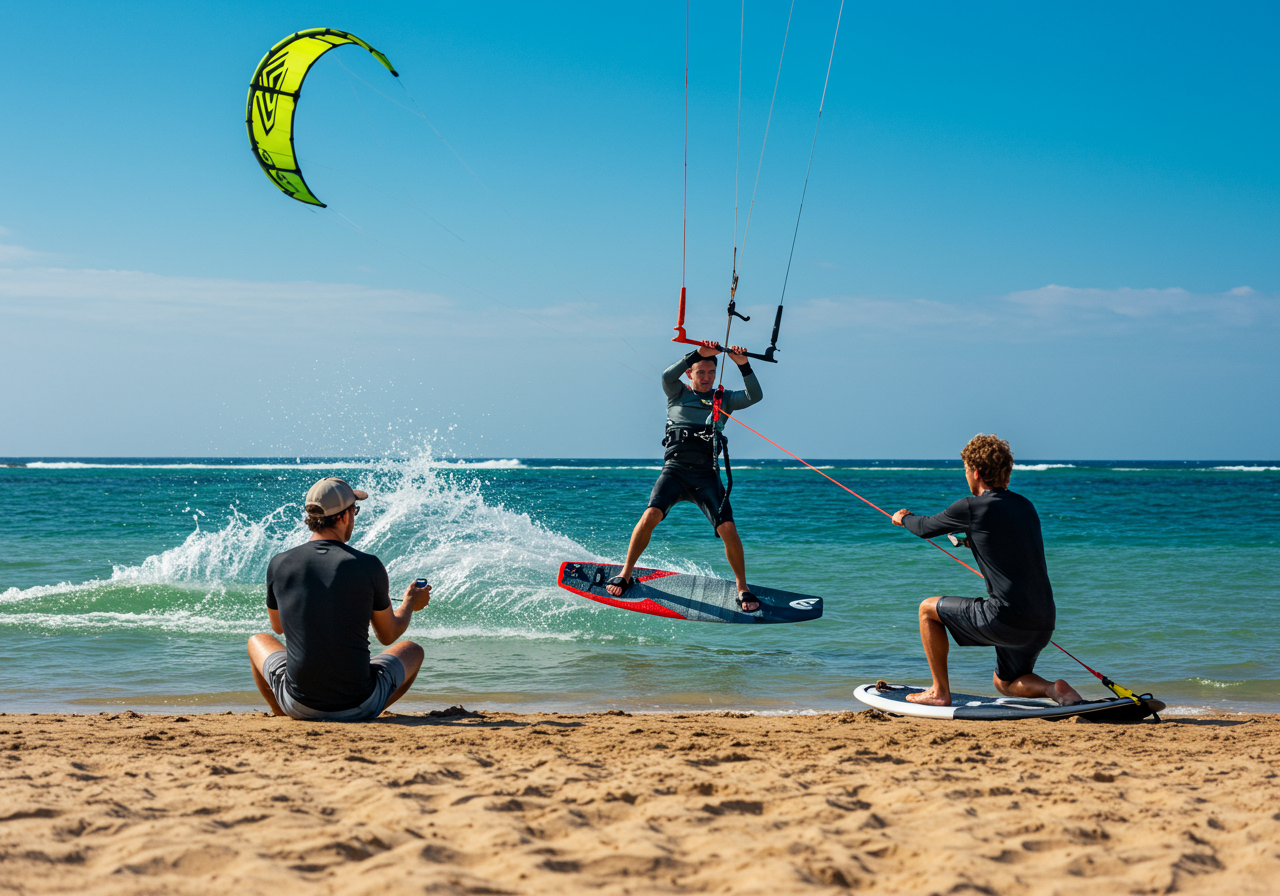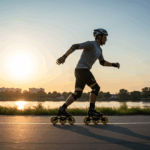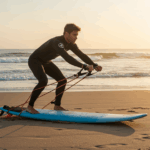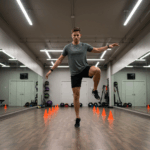Build Your Kitesurf Engine: Skills, Safety, and Body Basics

Build foundational control and the body that steers the kite
Kitesurf progress starts with control. You must steer the kite before chasing tricks. I coach beginners on beach drills first. This removes fear and builds automatic reactions.
- Edge to control speed. Your board edge creates resistance against the kite pull.
- Stack your posture. Hips forward, ribs down, eyes up, soft knees.
- Breathe during power spikes. Exhale to brace when the kite dives.
- Train three engines. Aerobic base, anaerobic bursts, and grip endurance.
Equipment choices affect learning. I start clients on bigger boards and stable kites. This reduces power spikes and knee stress.
Energy systems guide conditioning. Aerobic work builds staying power between runs. Anaerobic bursts handle sudden pulls and transitions.
- Fly a 2–3 m trainer kite for 15 minutes. Practice figure-eights.
- Do 3 sets of 20-second plank breathing. Focus on long exhales.
- Walk in sand for 10 minutes. Practice stance and edging angles.
| Skill | Body Cue | Drill |
|---|---|---|
| Kite steering | Relax forearms | One-hand fly, switch hands every 30 seconds |
| Waterstart setup | Knees toward chest | Sand sit-to-stand with handle pass mimic |
| Edging | Hips forward | Balance board edge holds, 20 seconds each side |
My background shapes this plan. I have kitesurfed for 12 years and coach weekly. I weigh 84 kg and use a Garmin watch to track heart rate zones.
Heart rate zones anchor training. I set zones with a Garmin field test. Zone 2 improves endurance. Zone 4 boosts power for sprints and pops.
Weekly Training Blueprint for Kitesurfers

Train on land so the water sessions feel easy
A clear weekly plan builds consistent progress. We blend strength, cardio, mobility, and skill. Sessions stay short but focused.
- Warm-up: 5 minutes band rows and hip openers.
- Trap-bar deadlift: 3×5 at moderate load, 2 minutes rest.
- Half-kneeling cable press: 3×8 each side, 60 seconds rest.
- Farmers carry: 4×30 meters, heavy but safe.
- Copenhagen side plank: 3×20 seconds each side.
| Level | Mon | Tue | Wed | Thu | Fri | Sat/Sun |
|---|---|---|---|---|---|---|
| Beginner | Strength A 35 min | Zone 2 cardio 30 min | Mobility 20 min | Strength B 35 min | Intervals 6x45s Z4 | Kitesurf or trainer kite |
| Intermediate | Strength A 45 min | Zone 2 40 min | Mobility + breath 25 min | Strength B 45 min | Intervals 8x60s Z4 | Kitesurf skills and transitions |
| Advanced | Strength A 55 min | Zone 2 50 min | Mobility 30 min | Strength B 55 min | Sprint blocks 10x30s Z5 | Freestyle or long tacks |
Strength A focuses on lower body and grip. Strength B targets upper body and core.
| Exercise | Sets x Reps | Rest | Notes |
|---|---|---|---|
| Trap-bar deadlift | 3–5 x 5 | 2–3 min | Hips forward, neutral spine |
| Bulgarian split squat | 3 x 8/leg | 90 sec | Drive through midfoot |
| Pull-ups or pulldown | 4 x 6–10 | 90 sec | Elbows down, not back |
| Half-kneeling cable press | 3 x 8/side | 60 sec | Ribs down, glute on |
| Pallof press | 3 x 12 | 45 sec | Resist rotation |
| Farmers carry | 4 x 30 m | 60 sec | Crush grip, tall posture |
Log sessions for accountability. I use Strava for surf days and Garmin for heart rate zones. You can use MyFitnessPal for nutrition tracking.
Garmin | Strava | MyFitnessPal
Twelve-Week Build: Phases, Metrics, and Real Workouts

Progress in clear phases with measurable wins
Phased training reduces overwhelm. You improve one capacity at a time. Then you layer skills together.
- Weeks 1–4: Base. Master steering and body tension. Build Zone 2 engine.
- Weeks 5–8: Power. Add Zone 4 intervals. Start consistent waterstarts.
- Weeks 9–12: Skill under fatigue. Practice transitions and longer tacks.
| Metric | Start | Week 6 | Week 12 |
|---|---|---|---|
| VO2 max (Garmin est.) | 42 | ~45 (+8%) | ~47 (+12%) |
| Continuous ride time | 3 minutes | 9 minutes | 18+ minutes |
| Grip endurance hold | 30 seconds | 55 seconds | 75 seconds |
Here are my real sessions. I wore a Garmin Forerunner. I tracked HR and RPE.
- Week 2 Zone 2: 40 minutes cycling at 125–135 bpm. RPE 4. Felt smooth.
- Week 6 Intervals: 8×60 seconds at 165–172 bpm. 90 seconds easy between. Legs burned, control held.
- Week 9 Strength: Trap-bar deadlift 4×4 at 160 kg. Farmers carry 5×35 m heavy.
- Week 10 Water: 75 minutes, average 138 bpm. Ten clean waterstarts, six heel-to-toe turns.
Progression follows load rules. I add 2.5–5 kg each week if technique holds. I extend intervals by 10–15 seconds after week four.
HIIT improved fat loss better than steady-state for me. My belt size dropped one notch by week eight. However, Zone 2 protected recovery and increased total sessions.
Track outcomes weekly. Use Strava for water distance and tacks. Use Garmin to confirm time in Zone 2 and Zone 4.
Fuel, Repair, and Stay Unbroken

Eat and recover so performance sticks
Nutrition allows skills to stick. Under-fueled riders fatigue and crash early. Balanced intake supports learning and recovery.
| Nutrition target | Range | Notes |
|---|---|---|
| Calories | Bodyweight x 32–36 | Lower for fat loss, higher for windy weeks |
| Protein | 1.6–2.2 g/kg | Supports muscle repair and satiety |
| Carbs | 3–5 g/kg | Up to 6 g/kg on double sessions |
| Fat | 0.6–1.0 g/kg | Fill remaining calories |
Hydration prevents forearm pump. I aim for 500–750 ml per hour on water. I add electrolytes during hot days.
- Sleep 7.5–9 hours nightly. Keep schedule consistent.
- Post-session meal: 0.3 g protein/kg plus carbs within 60 minutes.
- Breathing downregulation: 4 seconds inhale, 6 seconds exhale, 5 minutes.
- Mobility resets: thoracic rotations, hip flexor stretches, and ankle dorsiflexion.
Supplements can help, not replace food. I use creatine 3–5 g daily and omega-3s totaling 1–2 g EPA+DHA. I keep caffeine at 2–3 mg/kg before intense sessions.
My biggest mistake was skipping warm-up in gusty wind. A calf tweak benched me for ten days. Now I always do a five-minute band and ankle primer.
Use MyFitnessPal to keep macros honest. Adjust calories based on weekly bodyweight and energy levels.
Proof, Adjustments, and Real Outcomes

Validate progress and course-correct for long-term result interpretation
Results must show up on the water. We test skills, fitness, and consistency. Numbers guide decisions and keep you motivated.
| Rider | Before | After 10–12 weeks | Notes |
|---|---|---|---|
| Me (84 kg) | VO2 42, deadlift 160×2, 6 clean waterstarts | VO2 ~47, deadlift 170×3, 18-minute ride | Forearm pump reduced by 40% |
| Sara M., 38 | Fear of power, 50 m rides | 900 m continuous tack, first heel-to-toe turn | HIIT improved confidence and stability |
| Luis R., 29 | Inconsistent starts, low endurance | 10/12 successful waterstarts, 15% HRR improvement | Zone 2 base changed everything |
- Trainer kite figure-eights: Max reps in 2 minutes.
- Grip hang: Timed dead hang from bar.
- Shuttle run: 10×10 meters, record total time.
- On-water: Longest continuous tack distance from GPS.
Plateaus happen. Increase rest days or reduce interval count by two. Keep strength but lower reps for a week.
Motivation dips under flat forecasts. I schedule land skill play with a trainer kite. I also chase small wins with balance drills.
Troubleshooting injuries starts with patterns. Shoulder pain often follows poor rib position. Cue “ribs down, reach forward,” and swap pressing for landmine variations.
Keep your loop tight. Log sessions, eat enough, and sleep well. The ocean rewards consistency and smart adjustments.






